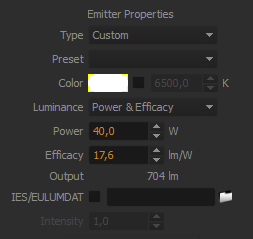Custom emitters
This option allows you to set the Color and the Intensity of your light separately. Color can be set in RBG, HSV or XYZ scales, or correlated to a Kelvin value. Intensity (or Luminance) can be set in a number of different ways (see next section). You can also specify an IES or Eulumdat file to light your scene, using measured lighting data for different lighting fixtures. These files are provided by many major lighting manufacturers.
Custom mode
Color
This parameter refers to the color of the light emitted. There are two ways to specify the color:
a. Using the Color Picker: Clicking on the colored square allows the user to choose a color in the Maxwell Render color picker.
Color: This parameter refers to the color of the light emitted. There are two ways to specify the color:
- Using the Color Picker: Clicking on the colored square allows the user to choose a color in the Maxwell Render color picker.
- Correlated Color at Kelvin Temperature (ºK): This options lets you choose the color that would correspond to an emission in Kelvin degrees. Please note that choosing this option will not make any changes in intensity, just color. Low Kelvin temperatures are reddish, 6500ºK is considered white, and higher values will produce a bluish light.
Luminance
Specifies the intensity of the light. There are several options to specify luminance, like Power & Efficacy, Lumens, Lux, Candelas and Luminance:
Luminance units
Power and Efficacy
This option allows you to specify how much electricity a light source consumes (Watts) and how efficiently it converts that electricity into visible light (Efficacy). The efficacy number specifies how many lumens are emitted per watt. For example, a common 40W incandescent light bulb will have a rather low efficacy of 12.6 lumens/ watt. This information is usually supplied by the bulb manufacturers. A more efficient energy saving bulb which is also rated at 40W will have an efficacy of perhaps 17.3 lumens/ watt, so for the same amount of energy consumed, it will emit more light.
The watts/efficacy way of specifying an emitter’s intensity is useful if you would like to mimic common light sources, where the manufacturer provides the watt rating and the efficacy rating. In the “Output” row you can see how many Lumens a particular watt/ efficacy setting will create.
Luminous power
Lumens (lm) is the SI (International System of Units) unit for luminous flux. It is a common way to specify how much light is emitted. Light manufacturers usually supply this data.
Illuminance
Lux (lum/m^2). Lux is the unit for specifying illuminance. It is defined as one lumen per square meter. This is a useful setting when you would like to increase or decrease the size of your emitter, and have it emit more or less light. If you use lumens and scale up your emitter, the same amount of lumens are emitted but from a larger area, giving the impression that the emitter is weaker. If you use Lux however, the amount of lumens increases/ decreases with the scale of your emitting surface.
Luminous Intensity
Candela (cd). Candela is considered the SI unit for luminous intensity; the power of the light emitted in a certain direction.
Luminance
Nit (cd/m^2). One “Nit” is one candela per square meter.
A note on Luminance type
It is important to remember that the amount of light emitted from an emitter is spread out across its surface.
This means that the same emitter material will look dimmer on a large emitting surface and brighter on a smaller emitting surface. You may also think something is wrong when scaling up your small emitter, since the amount of light falling on your subject looks like it has decreased:
The two emitters are using the same emitter material. On the right, the emitter emits the exact same amount of light as the smaller emitter, but since it is emitting it over a much larger area, there is less light focused on the statue, so it appears darker.
If you would like to keep your emitter the same brightness no matter the surface, then you should use the lumens/m2 units. Keep in mind though that this will actually change the amount of light emitted from the surface of the emitter when you change the emitter size.
Preset
Maxwell Render™ provides some emitter presets of standard type light sources. Please note these presets will change the color as well as the intensity of your emitters.
Emitter presets








